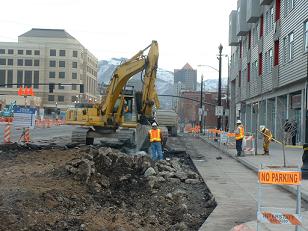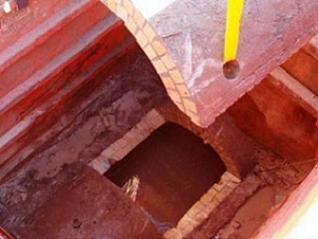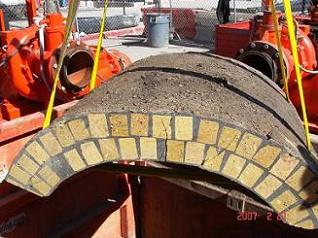Salt Lake City Intermodal Hub Projects
Work begins on underground utilities
By Chuck Call, Engineering Administrator
February 24, 2007
|
- Each of the 50-million passengers traveled an average of 5.35 miles per trip for a total of 267,253,423 miles
- The 50-million passagers that took TRAX saved: 259.8 million pounds of air pollution and 12.5 million gallons of gasoline
- If its current 19-miles of rail instead circled the equator, TRAX would have traveled around the world 10,750 times
Having adequate transportation options and decreasing air pollution are big challenges we are dealing with in the Salt Lake Valley. TRAX has helped.
To help solve some of these problems several major transportation projects have been planned, and they will all be completed during the next 18 months - Intermodal Hub TRAX connection, commuter rail and relocation of many of the Union Pacific rail lines that go through Salt Lake City. This will be the culmination of the efforts of many groups who are interested in transportation issues in the City.
When completed, people will be able to take TRAX to the Intermodal Hub located at 600 West just south of 200 South and then board commuter rail, Greyhound bus or Amtrak. Also those coming into the City on any of those transportation systems can get to the University of Utah or Sandy City with the ease of just walking across the Intermodal Hub terminal and using TRAX.
TRAX extension to the Intermodal Hub
Work began on the TRAX extension to the Salt Lake Intermodal Hub on January 8, 2007. This project will extend TRAX from the current end of the line at the Arena Station, then south down 400 West past the Gateway Mall; turn west on 200 South and then south on 600 West to the Intermodal Hub. Three stations will be build - one at the Intermodal Hub, a second at 100 South and 400 West adjacent to the Gateway and a third future station at 500 West and 200 South.
|
One of the major utility elements is lining an existing 1895 vintage, 48-inch brick sewer to restore its strength and make sure it will not be damaged by future rail vibrations and train loads. One-thousand feet of this sewer line will be lined with cured-in-place pipe (CIPP). On February 21, 2007 a top section was removed to gain access to the sewer interior.
This TRAX project also requires relocation of a 30-inch waterline that was installed in 1986. The new 30-inch waterline will be relocated outside of the area of the track slab.
Commuter Rail Project
The commuter rail is being installed at the same time by CRC. It will stretch north 44 miles from Salt Lake City to Pleasant View in Weber County, and eventually to Utah County on the south. The alignment will be along the east side of the existing Union Pacific rail road lines.
The TRAX project is timed to finish when the commuter rail tracks reach Salt Lake City. Commuter rail passengers will be able to cross a platform to catch TRAX or UTA buses. The Commuter Rail trains will travel as fast as 70 MPH - making the trip to Ogden in a very short time.
Railroad Realignment
At the same time as the TRAX and Commuter rail projects, Union Pacific is realigning their tracks as they come through the City and increasing the radiuses on the curves. This will allow trains to move through the City at about 40 MPH - in contrast to the current speed of 10 MPH. As part of this project the rail line on 900 South in the Glendale area will be abandoned.
Conclusion
It is anticipated that with the coming juncture of two mass transit rail systems at the Salt Lake Intermodal Hub, the surrounding area is going to change dramatically. City officials believe that the 19-block transit-oriented neighborhood between North Temple and 400 South, from 400 West to Interstate 15, could house up to 20,000 people who would live in rowhouses, townhomes and apartments next to or over the neigborhood shops and offices.


